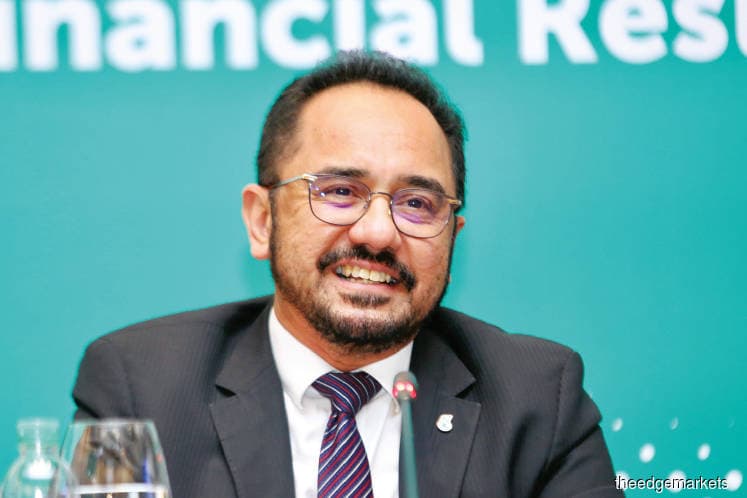
This article first appeared in The Edge Financial Daily on February 27, 2020
KUALA LUMPUR: Petroliam Nasional Bhd (Petronas) has hinted at a bearish outlook for 2020. The short-term headwind from the Covid-19 outbreak added pressure to the current low energy prices and weak demand.
Petronas is experiencing weaker demand in the current quarter, due to the slowdown in China, the epicentre of the Covid-19 virus, said Petronas president and group chief executive officer (CEO) Tan Sri Wan Zulkiflee Wan Ariffin.
“Demand has really softened. [This has affected] not only LNG (liquefied natural gas), but certain types of petrochemicals as well — methanol, paraxylene, and derivatives,” said Wan Zulkiflee.
However, the impact is also dependent on how long the virus outbreak will last, he told the media at Petronas’ financial results briefing here yesterday.
“The whole industry was not prepared for this black swan event. But this is not the first time that we go through this kind of price volatility, what is important for Petronas is to have a resilient business model which can handle these headwinds,” the CEO explained.
China contributes about 6% of the group’s revenue, according to Wan Zulkiflee.
The ongoing geopolitical uncertainties, prolonged trade tensions and near-term demand disruptions mainly due to the epidemic are also the headwinds, according to Petronas group chief financial officer Tengku Muhammad Taufik Tengku Aziz.
“The board expects that the financial performance for the year 2020 will be affected by these factors,” Muhammad Taufik said at the briefing.
“Notwithstanding these challenges, Petronas remains focused on delivering operational excellence and remains committed to our three-pronged strategy of maximising cash generation, expanding core business, and stepping out into new ventures,” he added.
According to reports, China’s demand for LNG — which imported 96.56 million tonnes per annum (mtpa) in 2019 — could slow by around 13.6mtpa in the first half of 2020.
It was reported in early February that China National Offshore Oil Corp (CNOOC) has declared force majeure on LNG contracts. Petronas has a long-term contract with CNOOC, the largest LNG importer in China, at a volume of 3.03mtpa.
Petronas sold 30.6 million tonnes of LNG in 2019, up 6% from 28.9 million tonnes in 2018.
The soft oil market had taken a toll on the national oil company since last year, which delivered its weakest annual and quarterly profit since 2016 for the financial year ended Dec 31, 2019 (FY19).
This was despite Petronas’ total oil and gas production increasing by 1.91% to 2,406 kilo barrel of oil equivalent per day (kboe/d) from 2,361kboe/d in 2018, and 4% growth in sales volume entitlement to 1,751kboe/d in 2019, from 1,681 kboe/d the year before.
The uptick, Petronas said, was mainly attributable to higher liquid production internationally, and higher natural gas production in Malaysia.
This year, Petronas is expecting to increase its Malaysian production by about 5%, as it increases its domestic capital expenditure (capex) allocation to between RM26 billion and RM28 billion this year with an emphasis on upstream projects.
The national oil firm has maintained its overall capex estimate at RM50 billion for 2020. It spent RM47.8 billion in capex last year, up from RM46.9 billion in 2018.
The group is also allocating 5% or around RM2.5 billion for renewable energy ventures. Last year, Petronas launched its own rooftop solar solution in Malaysia, building on the acquisition of Singapore-based solar energy solutions company Amplus Energy Solutions Pte Ltd last year.
Marginal field venture still in test phase
Meanwhile, Wan Zulkiflee explained that Petronas’ re-entry into marginal field development will start as an internal initiative, in order to determine its viability.
“In the past, we have issued risk-sharing contracts. At the moment, we are trying out within the Petronas group first to see if it makes sense, whether there is sensible and equitable risk allocation.
“Any development of marginal or small fields, we will make sure there is value, and we will have fiscal terms that would make sense for Petronas and contractors involved,” Wan Zulkiflee said.
“We need to make it attractive, and commercially viable for contractors to participate. If we don’t develop, [the hydrocarbon] is stranded in the ground,” he added.
In its latest Petronas Activity Outlook report for 2020-2022, Petronas said it has launched a new licensing round for four marginal field clusters. Bidding is open until May this year.
The last time it initiated the marginal oil field development locally was in 2013, when it opened its third risk-sharing contract licensing round for 10 marginal fields.